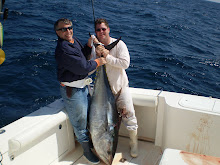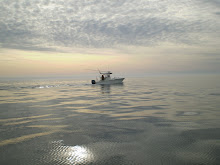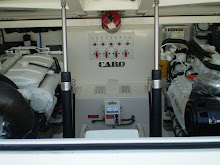
Here is an excellent editorial from today's WSJ written by an oceanographer and addressing how far contamination from the Gulf catrastrophe could spread. His discussion of ocean layers and currents is fascinating. So much we don't know about the big blue sea....
How Far Will the Gulf Gusher Spread?
By CURTIS C. EBBESMEYER
In the early 1990s, thousands of desperate Cuban balseros cast themselves adrift on rafts, tires and any other makeshift craft that could float. They shoved off even from the island's far shore, entrusting their lives to the powerful Loop Current that pushes north from the Yucatán, rounds Cuba, rushes through the Florida Straits, and spills into the Atlantic, seeding the Gulf Stream. Many drowned or perished from thirst. But others survived to wash up on Florida's east coast.
Now the Loop Current is in the news once again. Oil from the Deepwater Horizon gusher—please don't call it a "spill"—has begun trickling into the current, prompting anxious speculation as to how much will be swept up and where it will be borne. Only a small quantity of surface oil has been seen entering the current, but much more swirls below. Given the complex natures of both petroleum and marine waters, these underwater plumes will be extremely difficult to measure and track.
Oil is far from a homogenous substance, even before it gets emulsified by waves, currents and sun. It's a complex mixture of liquids, gases and waxy solids that vary widely in weight and solubility. Ocean waters are likewise not uniform; they are made up of distinct water slabs differentiated by temperature and salinity, and propelled by wind and currents. When I first began using monitoring equipment—newly available in 1967—I tracked these water bodies-within-bodies and dubbed them "snarks" because of their elusiveness.
With their wide temperature range, Gulf waters are especially rich in snarks. Clouds of oil will become trapped in them and carried far into the Atlantic. How far? In 1977, as part of a joint U.S.-Soviet oceanographic project, I traced 10 deepwater snarks, whose temperature, salinity and chemical signatures revealed that they had traveled across thousands of miles of the Atlantic Ocean.
Trapped in such blobs, the oil from Deepwater Horizon will ride the Gulf Stream across the Atlantic. In years to come, some will wash up on European shores, and some will reach the Arctic Ocean and continue along global conveyor belts of currents. Whales, dolphins and other animals will dive through the petro-infused slabs, suffering possible toxic exposures. The unprecedented deepwater injection of chemical dispersants to break up the petroleum before it reaches the surface may only worsen the impact. It will cause more oil to remain suspended longer in these stratified slabs, where there is no way to remove it.
The Atlantic is not the only route the oil will take. Each year the Loop Current becomes "pregnant," bulging out toward Louisiana—and Deepwater Horizon. Sometimes the current loops back tightly enough to squeeze this bulge like a tied-off balloon, releasing a constellation of spinning eddies. Unlucky balseros who launched into the Loop Current in summer 1994 wound up swirling helplessly in these eddies, never nearing Florida.
Some eddies veer west, bouncing along the continental shelf at about three miles per day toward Texas. By late last month, according to mapping by Mitchell A. Roffer's highly regarded ocean forecasting service, this process had already begun: Tentacles of oil were extending west past the Loop Current. One eddy appears to have broken off and begun crawling to Texas. It may entrain escaping oil deep underwater for several months, relieving the Florida, Alabama and Mississippi coasts and the upper water column where most marine life lies.
By August, however, it will have moved too far from the wellhead to continue capturing the oil, which will resume flowing toward Florida. The westward-bound oil will weather, clumping into tarballs. Most of them will wash up along "the graveyard of the Gulf," Texas's Great Bend coast, just as debris from Hurricane Katrina did.
More crude will leach out from Louisiana's spongy coastal wetlands, where it's now being absorbed, and also drift toward Texas. We will rediscover Deepwater Horizon's effects for many years to come.
Every 20 years or so, another oceanic oil spill or blowout reshapes our attitudes to petroleum and to the environment as a whole. In 1969, 20 years after the advent of offshore drilling, the Union Oil blowout off Santa Barbara forced us to confront its inherent risks and the cost of our hunger for fossil fuels. It inspired the first Earth Day and helped prompt the great wave of environmental regulation in the early 1970s. It may also have led to my being hired as Mobil Oil's first staff oceanographer, and enabled my colleagues and me to persuade the oil companies to build for much higher waves and stronger currents than they'd previously anticipated.
Ten years later, the Ixtoc 1 blowout—further south in the Gulf of Mexico, and a closer precedent for Deepwater Horizon—lasted 10 months and spewed more oil than any other accident. Because it involved a Mexican company and happened outside U.S. waters, it did not register with the same force in this country. But in 1989 the smaller but more visible Exxon Valdez spill delivered a wake-up call that still registers today. It brought home how vulnerable single-hulled tankers are, and it's still showing that spilled oil can persist in ecosystems for more than two decades.
We will also learn much from Deepwater Horizon, but at a great price.
Mr. Ebbesmeyer is co-author, with Eric Scigliano, of "Flotsametrics and the Floating World" (Smithsonian Books, 2009). He worked for three decades as a consulting oceanographer for environmental agencies and oil companies in Alaska and on Puget Sound, the Gulf of Mexico, the North Sea and the South China Sea.









No comments:
Post a Comment